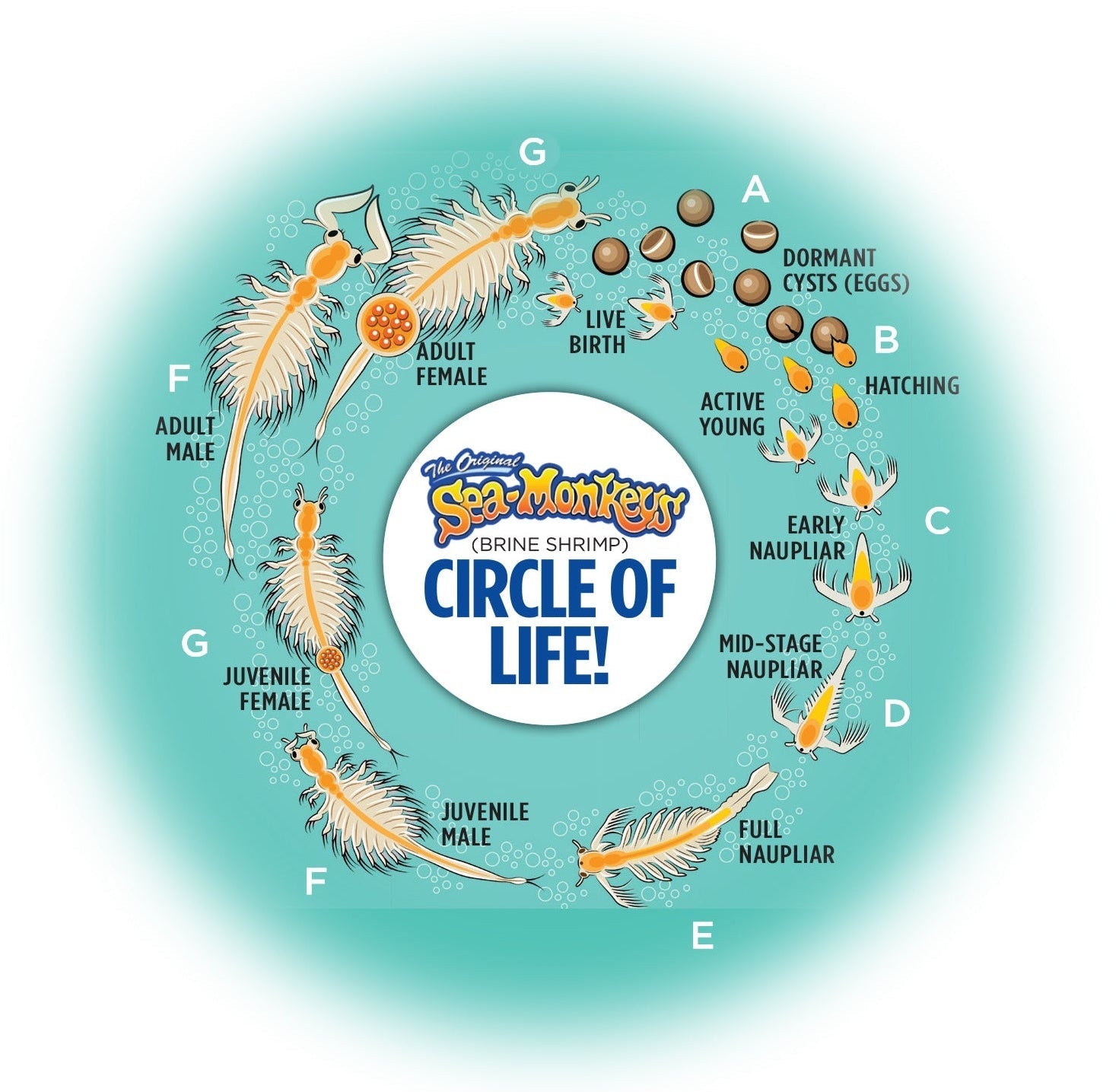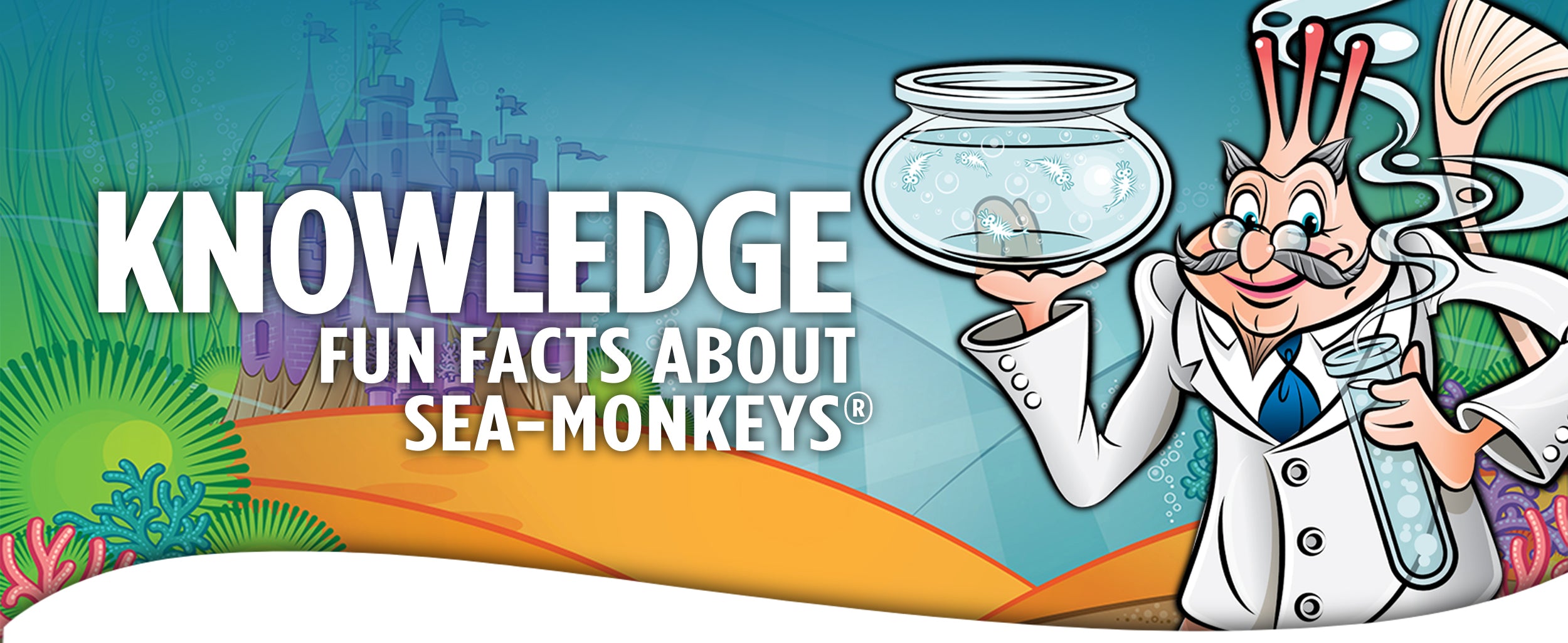THE UNBREAKABLE “CHAIN OF LIFE!”
Once Sea-Monkeys® have reached the adult stage of growth, they will begin breeding by themselves. However, there are some things that you can do to encourage their maximum breeding potential. As an example, at room temperatures (in the 65• to 75• F or 18-24 Celsius range), the mating tendency will be at its highest point. At lower temperatures, they will rarely mate. When breeding, the male Sea-Monkey® pairs himself with a willing female by grasping her at the root of her tail (where it joins her torso.)

Sea-Monkeys® reproduce like other advanced animal species. A male Sea-Monkey® and a female Sea-Monkey® mate sexually, and thus new life is created. Lesser forms of life such as hydra and other simple animals reproduce through budding — or even through mitosis (splitting in two) which occurs among single-celled animaculae (micro-animals) such as Amobee and Paramecium.
Among Sea-Monkeys® however, in the absence of a mate, a strange, wonderful thing happens. Incredible as it may seem, some female Sea-Monkeys® bear offspring arthenogenises or self-conception! Parthenogenesis in Sea-Monkeys® is called “Meiotic” Parthenogenesis. Only Meiotic Parthenogenesis permits the continuous production of advantageous combinations of “genes” (complex, self-perpetuating protein molecules that transmit hereditary characteristics.)
Summed up, this means that Sea-Monkeys® have evolved a most extraordinary tenacity for life. It also suggests that if just a single female Sea-Monkey® survived a cataclysmic catastrophe that wiped all other animals including Sea-Monkeys® off the face of the earth, it is possible that this Sea-Monkey® “Eve” could recreate her species without an “Adam” and the race of Sea-Monkeys® would live again.
Five Reproduction Methods:
Here are FIVE incredible means nature has devised for Sea-Monkeys® to enter the world — protected forever by a seemingly unbreakable “chain of life.”
- VIVIPARITY - meaning live birth,
- OVIPARITY - birth through hatching from laid eggs,
- OVOVIVIPARITY - the babies develop inside eggs that hatch INSIDE the mother’s belly BEFORE they are born,
- NECROOVOVIVIPARITY - the ability for a deceased pregnant female, with viable oviparous eggs, to continue through the pregnancy cycle until her babies are born alive, and,
- PRETERMITTED OVIOARITY - an incredible biological mechanism that halts the development of the embryos with baby Sea-Monkeys® inside in a state of suspended animation.
They will continue their cycle of development and be born alive from their halted growth state when exposed to water.
What Exactly Are Sea-Monkeys®?
Sea-Monkeys® (Artemia nyos) are a special type of brine shrimp (Artemia salina). These tiny creatures grow to about half an inch to three-quarters of an inch long, though some rare cases have reported growth up to one inch! They typically live up to a year, but with proper care, some Sea-Monkey® colonies have thrived for as long as five years.
Why Do Sea-Monkeys® Make Great Pets?
Sea-Monkeys® are fun, lovable creatures that may be too small to hug but are easy to care for and enjoy. Unlike traditional pets that need to be walked and fed daily, Sea-Monkeys® require very little maintenance, making them one of the easiest pets to raise.
A Special Kind of Brine Shrimp — Super Sea-Monkeys®
Sea-Monkeys® are actually hybrid brine shrimp, specially engineered to grow larger and live longer than regular brine shrimp. Scientists designed them this way so they wouldn’t just live for a short time and disappear!
Brine shrimp are tough survivors. They can place their eggs in a state called cryptobiosis, meaning the eggs can remain dormant for years. Even if their habitat dries up completely, they can hatch and thrive again when water returns. This ability makes them fascinating creatures to study.
How Do Sea-Monkeys® Work?
Sea-Monkeys® are sold worldwide as tiny freeze-dried eggs that can come to life when placed in water. This is why they are often used as an educational science experiment. They are also commonly used as food for tropical fish due to their size and high protein content. Despite this, Sea-Monkeys® remain one of the most unique and enjoyable pets to watch and care for!







